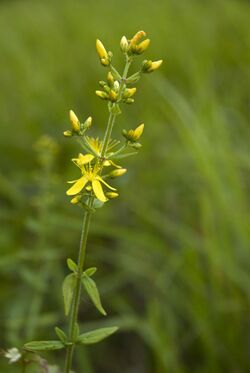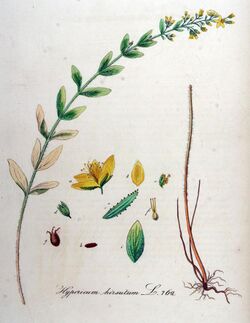Biology:Hypericum hirsutum
| Hypericum hirsutum | |
|---|---|

| |
| In Coteau de Chartèves (Aisne), France | |
| Scientific classification | |
| Kingdom: | Plantae |
| Clade: | Tracheophytes |
| Clade: | Angiosperms |
| Clade: | Eudicots |
| Clade: | Rosids |
| Order: | Malpighiales |
| Family: | Hypericaceae |
| Genus: | Hypericum |
| Section: | H. sect. Taeniocarpium |
| Species: | H. hirsutum
|
| Binomial name | |
| Hypericum hirsutum | |
Hypericum hirsutum is a species of flowering plant in the family Hypericaceae, commonly known as hairy St John's-wort.[1] It is found in Western Europe.
Description
Hypericum hirsutum is a downy perennial plant that grows to two or three feet. It has erect stems and opposite pairs of untoothed, elongated oval leaves with translucent glandular dots. The terminal inflorescences have many pale yellow flowers. Each has five pointed sepals with stalked black dots on the margins. The five petals also may have black dots and the many stamens are in bundles. Hairy St John's wort is very similar to common St John's wort (H. perforatum) but can be distinguished by the downy stems and the much longer leaves.[2]
Phytochemistry
Miquelianin (Quercetin 3-O-glucuronide), a type of phenolic compound, is present in H. hirsutum.[3]
Distribution
Hypericum hirsutum is a species of temperate regions and grows in Europe and western Siberia. It is uncommon and localised in Finland which is to the north of its European range[4] In Britain it is a widespread species except for the far north and west[5] while it is rare and localised in Ireland being found at only two sites in Northern Ireland and with its Irish range centred around County Dublin.[6]
Habitat and ecology
Hypericum hirsutum is a perennial herb which prefers free-draining, neutral to base-rich soils. It grows in open or partially shaded habitats such as rough and ungrazed grassland, clearings and rides in woodland, on the banks of rivers and road verges. In Britain it has an altitudinal range from sea level to 450 metres (1,480 ft) in Cumberland.[7] At the very northern extreme of its range, in south-western Finland it grows in the open, lime rich situations and does not grow in shade.[4]
References
- ↑ (xls) BSBI List 2007, Botanical Society of Britain and Ireland, https://bsbi.org/download/3542/, retrieved 2014-10-17
- ↑ McKlintock, D.; R. S. R. Fitter (1956). The Pocket Guide to Wild Flowers. Collins, London. p. 29.
- ↑ G. M. Kitanov (1988). "Miquelianin and other polyphenols from Hypericum hirsutum". Chemistry of Natural Compounds 24 (1): 119–120. doi:10.1007/BF00597593.
- ↑ 4.0 4.1 "Hairy St. John's-wort Hypericum hirsutum". LuontoPortti / NatureGate. http://www.luontoportti.com/suomi/en/kukkakasvit/hairy-st-johns-wort.
- ↑ "Hairy St John's-wort - Hypericum hirsutum". NatureSpot Recording the Wildlife of Leicestershire and Rutland. https://www.naturespot.org.uk/species/hairy-st-johns-wort.
- ↑ "Hypericum hirsutum L. - Hairy St. John's-wort - Guttiferae / Hypericaceae / Clusiaceae". National Museums Northern Ireland. http://www.habitas.org.uk/flora/species.asp?item=2967.
- ↑ "Hypericum hirsutum". Online Atlas of British and Irish Flora. Botanical Society of Britain and Ireland. https://www.brc.ac.uk/plantatlas/plant/hypericum-hirsutum.
Wikidata ☰ Q159185 entry
 |


